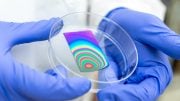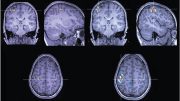
The team has developed a world-leading MWP chip capable of performing ultrafast analog electronic signal processing and computation using optics. Credit: City University of Hong Kong
A research team has unveiled a microwave photonic chip that significantly enhances analog electronic signal processing, offering 1,000 times the speed and greater energy efficiency than existing processors. This innovation promises to revolutionize various sectors, including wireless communications and artificial intelligence.
A research team led by Professor Wang Cheng from the Department of Electrical Engineering (EE) at City University of Hong Kong (CityUHK) has developed a world-leading microwave photonic chip that is capable of performing ultrafast analog electronic signal processing and computation using optics.
The chip, which is 1,000 times faster and consumes less energy than a traditional electronic processor, has a wide range of applications, covering 5/6G wireless communication systems, high-resolution radar systems, artificial intelligence, computer vision, and image/video processing.
The team’s research findings were published in the prestigious scientific journal Nature titled “Integrated Lithium Niobate Microwave Photonic Processing Engine.” It is a collaborative research with The Chinese University of Hong Kong (CUHK).
Addressing Modern Communication Challenges
The rapid expansion of wireless networks, the Internet of Things, and cloud-based services has placed significant demands on underlying radio frequency systems. Microwave photonics (MWP) technology, which uses optical components for microwave signal generation, transmission, and manipulation, offers effective solutions to these challenges. However, integrated MWP systems have struggled to simultaneously achieve ultrahigh-speed analog signal processing with chip-scale integration, high fidelity, and low power.
“To address these challenges, our team developed a MWP system that combines ultrafast electro-optic (EO) conversion with low-loss, multifunctional signal processing on a single integrated chip, which has not been achieved before,” explained Professor Wang.
Such performance is enabled by an integrated MWP processing engine based on a thin-film lithium niobate (LN) platform capable of performing multi-purpose processing and computation tasks of analog signals.
“The chip can perform high-speed analog computation with ultrabroad processing bandwidths of 67 GHz and excellent computation accuracies,” said Feng Hanke, PhD student of EE and the first author of the paper.
Pioneering Lithium Niobate Photonics
The team has been dedicated to researching the integrated LN photonic platform for several years. In 2018, colleagues at Harvard University and Nokia Bell labs developed the world’s first CMOS (complementary metal-oxide semiconductor)-compatible integrated electro-optic modulators on the LN platform, laying the foundation for the current research breakthrough. LN is referred to as the “silicon of photonics” for its importance to photonics, comparable to silicon in microelectronics.
Their work opens up a new research field, i.e., LN microwave photonics, enabling microwave photonics chips with compact sizes, high signal fidelity, and low latency; it also represents a chip-scale analog electronic processing and computing engine.
Reference: “Integrated lithium niobate microwave photonic processing engine” by Hanke Feng, Tong Ge, Xiaoqing Guo, Benshan Wang, Yiwen Zhang, Zhaoxi Chen, Sha Zhu, Ke Zhang, Wenzhao Sun, Chaoran Huang, Yixuan Yuan and Cheng Wang, 28 February 2024, Nature.
DOI: 10.1038/s41586-024-07078-9
The paper’s first authors are Feng Hanke and Ge Tong (EE undergraduate). Professor Wang is the corresponding author. Other contributing authors include Dr. Guo Xiaoqing, PhD graduate of EE; Dr. Chen Zhaoxi, Dr. Zhang Ke, Dr. Zhu Sha (also at Beijing University of Technology), Dr. Sun Wenzhao (now at CityUHK (Dongguan)), EE postdocs; and Zhang Yiwen, EE PhD student; and collaborators (Wang Benshan, Professor Huang Chaoran, and Professor Yuan Yixuan) from CUHK.








Be the first to comment on "1,000x Faster: Ultrafast Photonics Chip Reshapes Signal Processing"